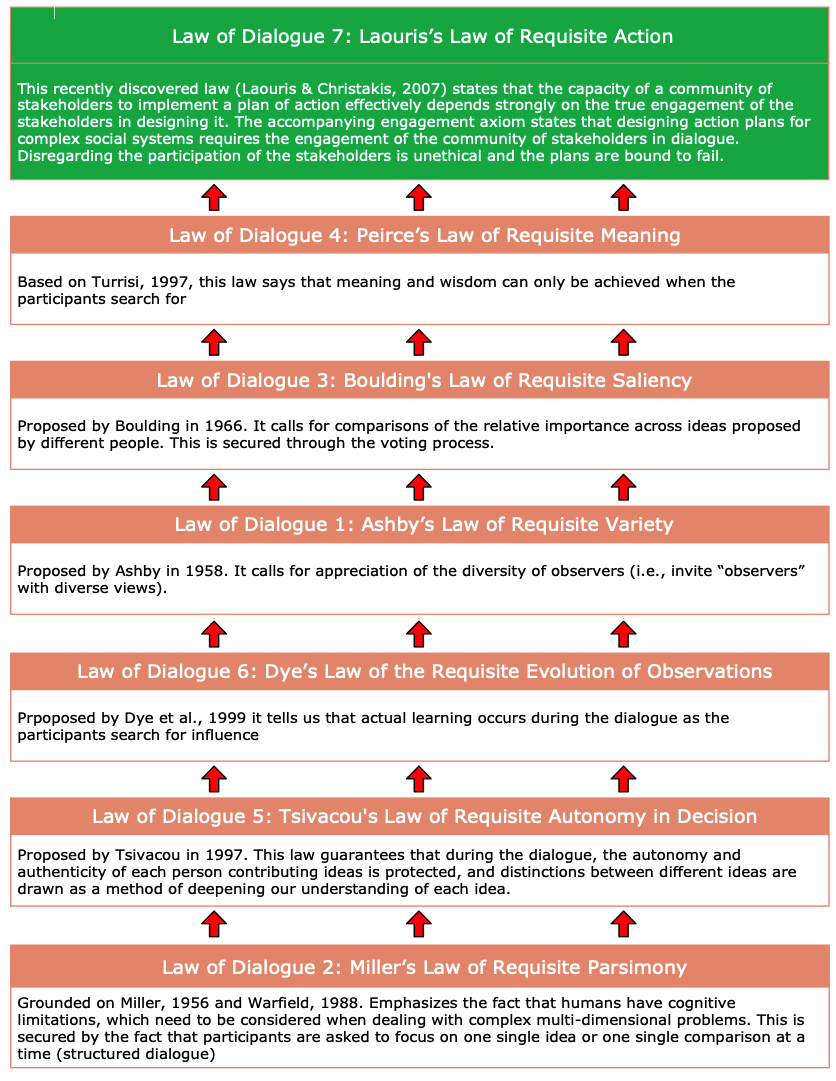The Tree of Action: Difference between revisions
(Created page the tree of action) |
No edit summary |
||
| (2 intermediate revisions by the same user not shown) | |||
| Line 4: | Line 4: | ||
The relationships among the seven Laws of the Dialogic Design Science are displayed graphically in the Tree diagram shown below, which is referred in the DDS literature as the “Tree of Action.” The Tree shows, by means of the arrows propagating from bottom up, the enhancement relationship among the seven Laws. | The relationships among the seven Laws of the Dialogic Design Science are displayed graphically in the Tree diagram shown below, which is referred in the DDS literature as the “Tree of Action.” The Tree shows, by means of the arrows propagating from bottom up, the enhancement relationship among the seven Laws. | ||
[[File: TreeOfActionDiagram.png |thumb|center|upright=3.0|alt=The Tree of Action]] | |||
The [[Law of Requisite Parsimony]], attributed to [[Miller]], is at the root of the Tree of Action, implying that ensuring that the cognitive limitations of the participants are honored during a dialogue will enhance all the other laws along the pathway of the arrows displayed in the Tree, culminating at the top level to the fulfillment of the [[Yiannis Laouris|Laouris]] [[Law of Requisite Action]]. | |||
Authentic and productive dialogue among the group of stakeholders necessitates that structured dialogue Facilitation teams ensure that all seven Laws are being enforced in accordance with the enhancement pathway of the Tree of Action. Enforcing “Parsimony” enhances the “Autonomy” of the participants, enabling them to experience the "Evolution" of observations and to learn from each other. As they learn together they begin to appreciate the “Variety” of observations, which contributes in reassessing their original views about “Saliency,” and leads to a deeper understanding of the “Meaning” of the ideas authored by other participants. The understanding of the meanings of the proposals leads to buy-in and the commitment to “Action,” because the participants own the definition of the problem situation and the collaborative design of an action agenda. | Authentic and productive dialogue among the group of stakeholders necessitates that structured dialogue Facilitation teams ensure that all seven Laws are being enforced in accordance with the enhancement pathway of the Tree of Action. Enforcing “Parsimony” enhances the “Autonomy” of the participants, enabling them to experience the "Evolution" of observations and to learn from each other. As they learn together they begin to appreciate the “Variety” of observations, which contributes in reassessing their original views about “Saliency,” and leads to a deeper understanding of the “Meaning” of the ideas authored by other participants. The understanding of the meanings of the proposals leads to buy-in and the commitment to “Action,” because the participants own the definition of the problem situation and the collaborative design of an action agenda. | ||
The reader interested to learn more about the science of Dialogic Design and the Tree of Action should consult some of the relevant literature about the science, and in particular (Christakis, 2006; Laouris, 2008; Flanagan & Christakis, 2010 in the Books and Reports entry of the Navigation Panel of this wiki). | The reader interested to learn more about the science of Dialogic Design and the Tree of Action should consult some of the relevant literature about the science, and in particular (Christakis, 2006; Laouris, 2008; Flanagan & Christakis, 2010 in the Books and Reports entry of the Navigation Panel of this wiki). | ||
If you are interested to construct the Tree of Action by using retroductive logic please visit the Dialogue Game in: | If you are interested to construct the Tree of Action by using [[Retroductive Logic|retroductive logic]] please visit the Dialogue Game in: | ||
Latest revision as of 15:18, 28 August 2022
The relationships among the seven Laws of the Dialogic Design Science are displayed graphically in the Tree diagram shown below, which is referred in the DDS literature as the “Tree of Action.” The Tree shows, by means of the arrows propagating from bottom up, the enhancement relationship among the seven Laws.
The Law of Requisite Parsimony, attributed to Miller, is at the root of the Tree of Action, implying that ensuring that the cognitive limitations of the participants are honored during a dialogue will enhance all the other laws along the pathway of the arrows displayed in the Tree, culminating at the top level to the fulfillment of the Laouris Law of Requisite Action.
Authentic and productive dialogue among the group of stakeholders necessitates that structured dialogue Facilitation teams ensure that all seven Laws are being enforced in accordance with the enhancement pathway of the Tree of Action. Enforcing “Parsimony” enhances the “Autonomy” of the participants, enabling them to experience the "Evolution" of observations and to learn from each other. As they learn together they begin to appreciate the “Variety” of observations, which contributes in reassessing their original views about “Saliency,” and leads to a deeper understanding of the “Meaning” of the ideas authored by other participants. The understanding of the meanings of the proposals leads to buy-in and the commitment to “Action,” because the participants own the definition of the problem situation and the collaborative design of an action agenda. The reader interested to learn more about the science of Dialogic Design and the Tree of Action should consult some of the relevant literature about the science, and in particular (Christakis, 2006; Laouris, 2008; Flanagan & Christakis, 2010 in the Books and Reports entry of the Navigation Panel of this wiki). If you are interested to construct the Tree of Action by using retroductive logic please visit the Dialogue Game in:
